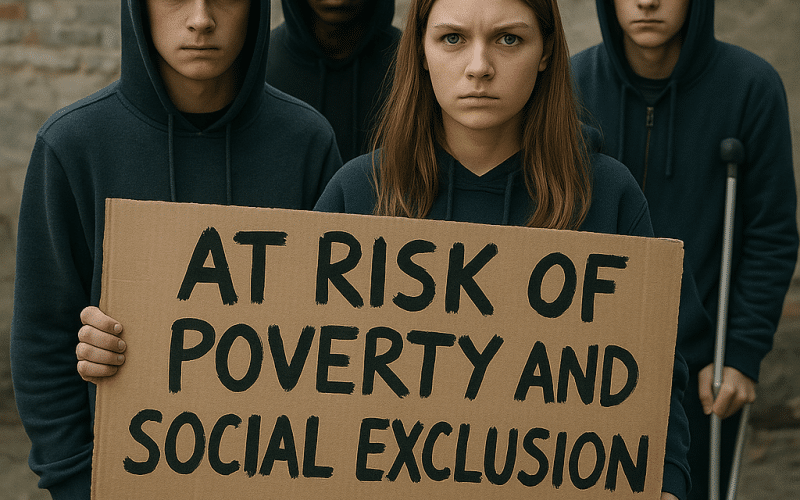
Despite progress in education, employment, and mobility across Europe, a sobering reality remains: nearly one in four young people in the European Union are at risk of poverty or social exclusion. These young people often live with limited financial resources, face barriers in accessing decent jobs, and may lack the social safety nets that older adults rely on. Those with low education levels or disabilities are even more likely to be left behind.
This article draws on the findings of the EU Youth Report 2024, published by the European Education and Culture Executive Agency (EACEA) in April 2025. Also included is supporting data from Eurostat and international institutions.
We will explain what this situation looks like across Europe, why it’s happening, and how EU countries can better support their young populations.
What’s Happening?
1 in 4 EU Youth Are Vulnerable
According to the 2024 EU Youth Report, about 24.5% of people aged 15–29 are at risk of poverty or social exclusion (AROPE). This equates to over 17 million young people. The risk is even higher in some countries, reaching almost 38% in Romania and over 30% in Bulgaria and Greece.
Table 1: Youth at Risk of Poverty or Social Exclusion, by Country (EU, 2023)
| Country | % of Youth at Risk (15–29) | Youth Population (Est.) | Youth at Risk (Approx.) |
|---|---|---|---|
| Romania | 37.9% | 3.0 million | ~1.14 million |
| Bulgaria | 32.4% | 1.2 million | ~0.39 million |
| Greece | 30.7% | 1.5 million | ~0.46 million |
| EU Average | 24.5% | 71 million | ~17.4 million |
| Czechia | 10.5% | 1.7 million | ~0.18 million |
| Slovenia | 10.7% | 0.5 million | ~0.05 million |
| Malta | 11.0% | 0.2 million | ~0.02 million |
Source: Eurostat, 2023 AROPE data for youth (15–29).
Why Are Young People at Risk?
Several overlapping factors explain why so many young people in Europe are struggling.
1. Low Educational Attainment
Education plays a major role in determining income and job stability. Young people with only primary or lower secondary education (known as ISCED levels 0–2) are more than three times as likely to be at risk of poverty or exclusion compared to those with university degrees.
Table 2: Risk of Poverty or Social Exclusion by Education Level (EU, 2024)
| Education Level | % of People at Risk (18+) |
|---|---|
| Low (ISCED 0–2) | 33.9% |
| Medium (ISCED 3–4) | 19.2% |
| High (ISCED 5–8) | 10.2% |
Example: A young man in rural Slovakia who left school at age 16 may find himself locked out of formal job opportunities, unable to access higher training programs, and stuck in precarious or informal work with no benefits.
2. Disability
Young people with disabilities are disproportionately affected. Eurostat data show that nearly 29% of young people with activity limitations are at risk of poverty or social exclusion, compared to just 18% of their non-disabled peers.
Table 3: Risk of Poverty or Social Exclusion by Disability Status (EU, 2023)
| Disability Status | At Risk (%) |
|---|---|
| With disability | 28.8% |
| Without disability | 18.0% |
Example: A 23-year-old woman with a mobility impairment in Portugal may face multiple hurdles — from lack of accessible transportation to discrimination in hiring — limiting her chances to secure meaningful, well-paid work.
3. Employment Instability
The rise in temporary, part-time, and gig work means that many young people, even if employed, still live below the poverty line. Unemployment and being “NEET” (Not in Employment, Education, or Training) are also strongly linked to social exclusion.
In 2023:
- 10% of young people in the EU were unemployed.
- 11.7% were NEETs.
- The highest NEET rates were seen in Italy, Romania, and Greece.
Example: A 19-year-old in Spain who finished vocational school may find that local employers only offer unpaid internships or seasonal contracts, making it difficult to plan for the future or move out of the parental home.
How Can We Fix This?
The EU and national governments have several tools and frameworks at their disposal to address youth poverty and exclusion. Here’s what needs to happen:
1. Expand Access to Education and Training
- Improve access to secondary and tertiary education, especially for rural, migrant, or minority communities.
- Strengthen vocational education and training (VET) programs.
- Encourage lifelong learning and digital upskilling for all youth.
Best Practice: The German dual education system combines classroom education with hands-on apprenticeships. It boasts one of the lowest youth unemployment rates in Europe.
2. Promote Inclusive Labour Markets
- Invest in youth employment programs such as the EU’s Youth Guarantee, which ensures all young people under 30 receive job offers, training, or apprenticeships within 4 months of leaving education or work.
- Create incentives for companies to hire and retain young people and persons with disabilities.
- Strengthen enforcement of anti-discrimination laws in hiring.
3. Strengthen Social Protection
- Ensure adequate income support, such as minimum income schemes, housing aid, and child benefits.
- Increase funding for mental health services and counselling in schools and community centers.
- Support NGOs working with marginalized groups (e.g., Roma youth, refugees, LGBTQ+ youth).
Best Practice: In Finland, universal student benefits and housing allowances help reduce poverty among low-income young adults, while also supporting their independence.
4. Invest in Disability-Inclusive Policies
- Ensure schools, training centers, and workplaces are physically and digitally accessible.
- Provide tailored support services, including job coaches and assistive technologies.
- Promote the active participation of young people with disabilities in policymaking.
Youth Poverty and Social Exclusion in Europe – Not just a Statistic
Youth poverty and social exclusion in Europe is not just a statistic — it affects real lives and futures. The fact that nearly one in four young Europeans is at risk should alarm policymakers, educators, employers, and citizens alike. Education, inclusive employment, and targeted social protections are not just moral imperatives but economic necessities for a sustainable future.
Reducing this risk will require coordinated action, investment, and political will. But it is possible — and urgent.
